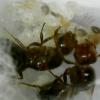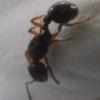1. Location of collection: Found these in my pool in my backyard, suburban area at night less than an hour after sunset.
2. Date of collection: 8/20/15
3. Habitat of collection: -
4. Length (from head to gaster): 5-6mm
5. Color, hue, pattern and texture: Brown, two of them might be yellow
6. Distinguishing characteristics: There might be at least two species, though I can't be sure. Perhaps some of them are males, but I also saw some distinctly male ants along with them in the pool. Two that seem smaller appear distinctly more yellow and the darker ones are bigger and have noticeably rough rugae on the head and a dark spot around their three occelli. The smaller ones have a singular node petiole. Two of them started to fight that I think were different species.
The big ones might be... Pheidole? And Dorymyrmex?


This seems like a two node?

Edited by BrittonLS, August 20 2015 - 9:17 PM.



















